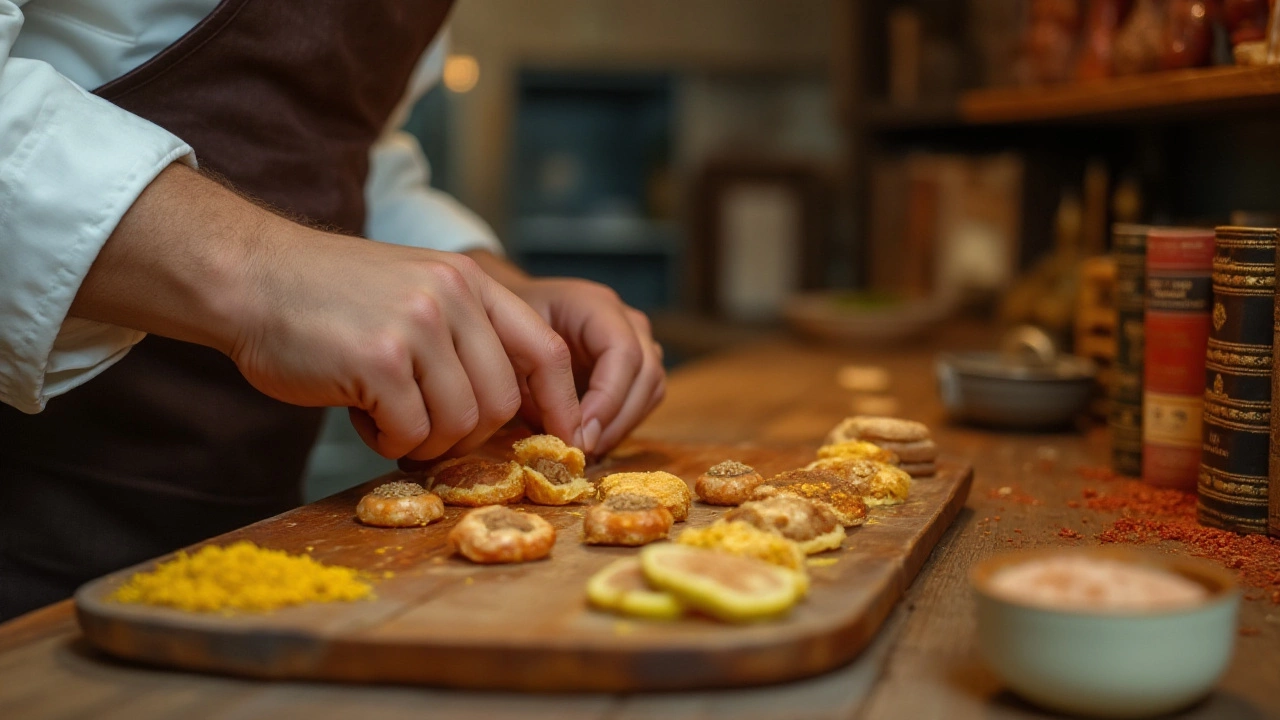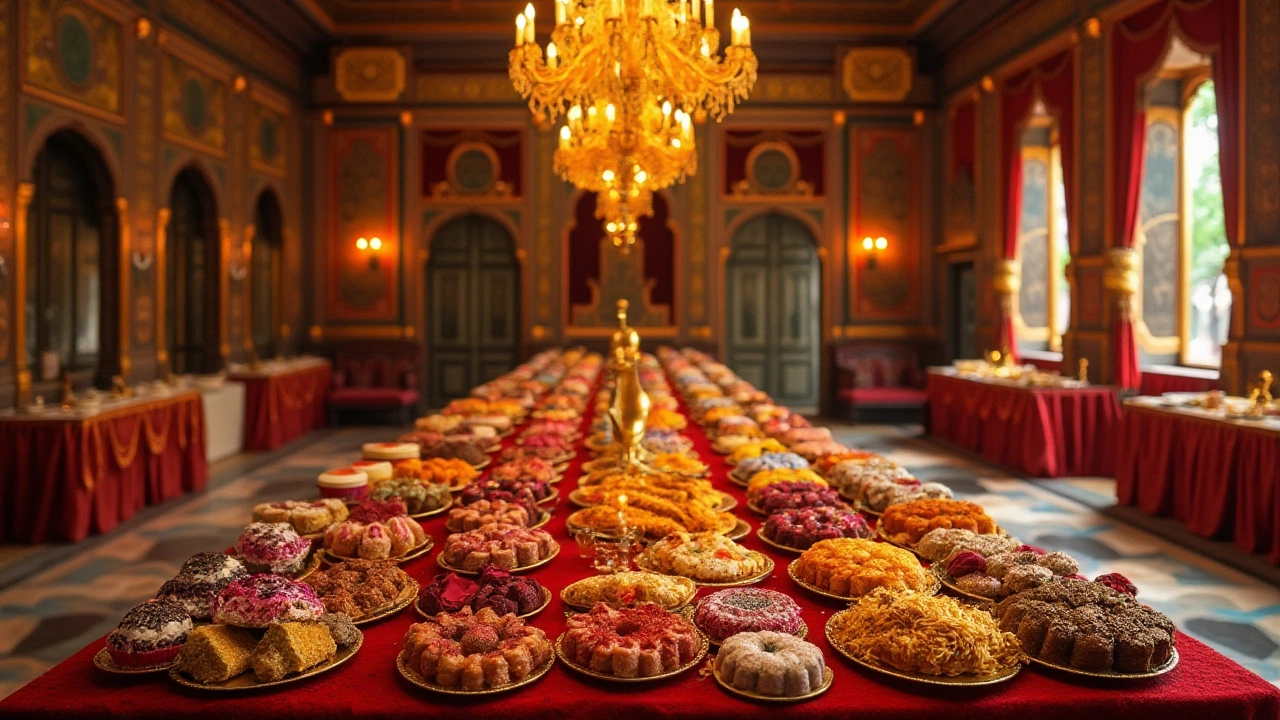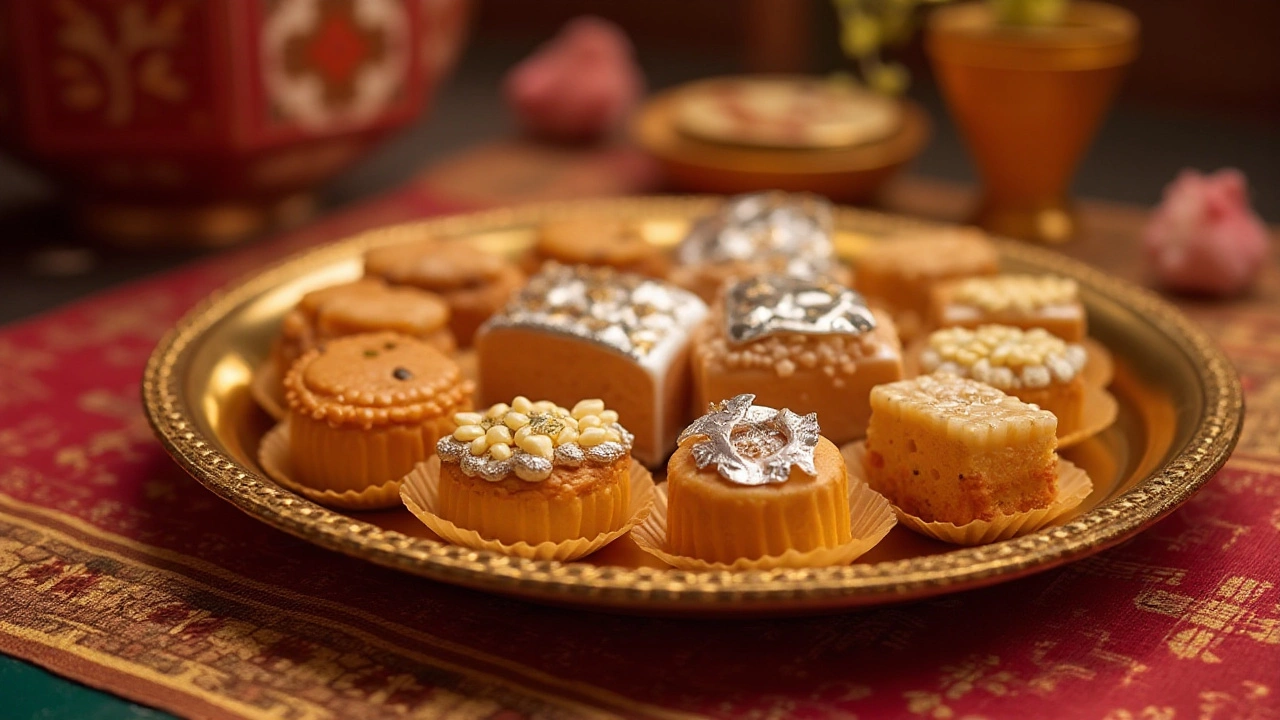When it comes to desserts, the Indian subcontinent offers an irresistible blend of flavors and textures, with some creations standing out as the epitome of luxury. These desserts aren't just about the taste; they are a reflection of cultural heritage, innovation, and the art of indulgence itself.
From the glittering gold embellishments to exotic saffron and pistachio notes, these decadent treats are crafted with meticulous attention to detail. They are as much a feast for the eyes as they are for the palate, making them a favorite among those with a penchant for the finer things in life.
Delve into the world of luxurious Indian sweets as we uncover the stories and secrets behind these culinary jewels, and discover what makes a dessert truly extraordinary.
- Defining Luxury in Desserts
- The Ingredients That Set Them Apart
- Famed Luxurious Desserts in India
- History and Origin of India's Most Exquisite Desserts
- Tips for Creating a Luxurious Dessert Experience at Home
Defining Luxury in Desserts
In the culinary universe, luxurious dessert is synonymous with exclusivity, refined taste, and unparalleled quality. Yet, what truly defines luxury in sweet confections, especially within the rich tapestry of Indian cuisine? At its essence, a luxurious dessert transcends mere indulgence, becoming a symbol of sophistication and artistry. It's a delightful culmination of premium ingredients, meticulous preparation, and exquisite presentation. Imagine a dessert crafted with the most fragrant saffron picked by hand, or high-quality pistachios sourced from distant lands, capturing the imagination as much as it does the taste.
The ingredients often dictate the level of luxury. Rare spices like cardamom and saffron, adorned with edible gold leaf or silver varq, and balanced with the subtle sweetness of organic raw sugar or the silkiness of ghee, elevate any sweet to a gourmand's delight. These elements collaborate harmoniously, creating a sensory experience that goes beyond the initial taste; it's a journey through history, culture, and passion, skillfully woven into a bite-sized wonder.
Meticulous Craftsmanship
The creation of such a dessert is where the art of culinary craftsmanship truly shines. Master chefs, often with years of dedication and passed-down knowledge, employ traditional techniques combined with innovative approaches to transform simple ingredients into masterpieces. The intent is not just to satisfy the sweet tooth but to create a moment that resonates with opulence and an appreciation for the finer things. Luxury desserts demand a personal touch, as no machine can replicate the keen eye for detail that a skilled artisan possesses.
"A dish should not only satisfy the stomach but also the soul, turning sweet memories into lasting traditions," says Renowned Pastry Chef Deepika Zalpuri.
While in recent years, the fusion of global trends with indigenous methods has introduced new dimensions to luxurious desserts in India, the inherent charm remains in their traditional roots. The intricate balance of flavors, texture, and aesthetics converges to form an exquisite result that is exquisitely luxurious yet distinctly Indian at heart. This nexus of past and present symbolizes the ever-evolving nature of luxury in desserts—it is not static but boundless and ripe for exploration.
Experiencing the Luxury
Experiencing a luxury dessert is akin to entering a curated exhibit of culinary art. Every detail—from its temperature and plating to its lingering aftertaste—aims to invoke a sense of awe and return to the roots of what makes a treat remarkable. As such, a truly luxurious dessert is never rushed; it’s a moment savored, a celebration of the exceptional and a tribute to what's possible when passion and luxury meet.
For some, the luxurious quality lies in the rarity of the flavors, while for others, it may be the decadent richness. Regardless, these desserts are ultimately about enjoying life's finest pleasures, offering a slice of tranquility in the hustle and bustle. Gourmet desserts open the door to tradition, innovation, and an intimate connection to something beautifully crafted. They stand as a testament to culinary mastery and heritage, artfully illustrating the essence of what it means to savor a truly luxurious dessert.
The Ingredients That Set Them Apart
In the world of luxurious dessert crafting, the use of premium and often rare ingredients is a defining trait. These ingredients not only elevate the flavor profile but also add an element of opulence that makes such desserts an extraordinary experience. At the top of the list is saffron, sometimes referred to as 'red gold', which is harvested from the delicate crocus flower. Known for its rich color and subtle aroma, saffron lends a unique essence and unmatched visual appeal to many Indian sweets. Only a few strands are needed to transform a simple dish into something truly lavish.
Another essential component is the use of dried fruits and nuts, especially almonds, pistachios, and cashews. These are often incorporated in abundance, bringing a delightful crunch and a creamy nuttiness that contributed to the richness of the dessert. In many regions, these nuts are specially sourced and prided for their superior quality and size, enhancing the dessert's texture and appeal. Similarly, the incorporation of exotic fruits like mango and lychee adds a brightness and a burst of flavor that elevates the dish to an high-end standard.
Of the luxurious ingredients used, silver and gold leaf, known as vark, stand out. While adding no particular flavor, their presence signifies extravagance and is believed to have cooling properties. Chefs apply this vark as a final flourish, leaving guests enchanted by their shimmering presentations. As written by Anand Subramaniam, a renowned food historian, "The tradition of embellishing sweets with precious metals dates back centuries and speaks of a time when lavish indulgence was accessible only to royalty."
The tradition of embellishing sweets with precious metals dates back centuries and speaks of a time when lavish indulgence was accessible only to royalty.
Sweeteners, too, play a pivotal role in defining the sumptuousness of a dessert. High-quality sugar and jaggery are often preferred for their purity and depth of flavor. Jaggery, in particular, adds a distinctive earthiness and richness that regular sugar lacks. There's also a growing trend toward using organic honey and natural sweeteners, respected for their health benefits and subtle flavors. The preference for these ingredients reflects a commitment to authenticity and tradition, often imparting a homey warmth intertwined with elegance.
In some regions, the fabled kheer, a type of rice pudding, is made distinctively luxurious by the inclusion of basmati rice renowned for its elongated grains and fragrant aroma. Coupled with full-fat milk that has been simmered to a creamy consistency, the sumptuous texture of these desserts lures even the most discerning palates. These ingredients, combined with expert techniques inherited through generations, create a tapestry of tastes and aromas that trigger a deep, sensory pleasure.
It's noteworthy that the quality of these key ingredients usually determines the dessert's status on the luxury scale. Artisans and confectioners are often meticulous in sourcing the finest available options, marking a benchmark for excellence in traditional and contemporary dessert recipes. In a world where culinary artistry is cherished, these extraordinary ingredients transform sweets into something more than just a food — they become a work of art, an experience, a moment of indulgence transformed through craftsmanship and nature's bounty.

Famed Luxurious Desserts in India
In the panorama of Indian sweets, some desserts have earned their stripes as true embodiments of luxury. Among these, the illustrious 'Mithai' stand tall, not just for their taste but for their rich histories and extravagant ingredients that spell opulence. Take for instance the iconic 'Ghevar', a dessert deeply intertwined with the festivities of Rajasthan. Its honeycomb-like structure, doused in sugary syrup, graced with pistachios and saffron threads, is a visual and sensory celebration. Ghevar is often prepared in various versions, from the traditional plain to the indulgent Mawa or Malai adaptations, each one telling a tale of meticulous craftsmanship and abundant usage of exclusive ingredients.
Another heirloom of indulgence is the 'Rabri', a dessert of thickened sweetened milk instituted with layers of clotted cream, garnished lavishly with edible silver leaves and slivers of nuts. Historically favored by the royals, Rabri is a labor of love, demanding slow cooking which coaxes out the deep, nutty flavors of the milk. The charm of Rabri lies in its creamy richness that melds seamlessly with the subtle fragrance of cardamom and rose. In the city of Varanasi, the Rabri served with the famed 'Malaiyo', a frothy milk preparation only available during the winter, stands as a testament to luxurious Indian culinary artistry at its best.
A famous saying from an Indian dessert connoisseur states,
“In India, desserts are not mere accompaniments; they hold a mirror to our diverse cultural identity and emphasize life’s occasions with sweetness.”The 'Kesar Pista Barfi' is yet another stalwart in the arena of luxurious desserts—staying true to its grandeur. This diamond-shaped sweet is enriched with the aromatic Kesar (saffron) and vibrant pistachios, a duo revered as symbols of affluence. Its melt-in-mouth texture is often a result of premium ingredients like pure milk and clarified butter, turning Barfi into an ethereal experience.
Moving to the eastern realms, we discover 'Chena Poda', meaning burnt cheese, celebrated for its caramelized crust and delicate sweetness. Originating from Odisha, it reflects profound skill in crafting a dessert that harmonizes creaminess with an earthy, smoky undertone. This dessert is no ordinary feat; it needs an exacting oven environment and the finest farmer's cheese to achieve its signature taste. The intricacies of Chena Poda's preparation only add to its allure as a luxurious sweet treasure.
To illustrate the celebrated 'Mishti Doi' from Bengal, a delectable concoction of silken yogurt infused with jaggery, deserves mention among the elite luxurious desserts. Traditionally set in earthen pots to absorb moisture, the velvety texture is unlike any, with a mild tanginess complemented by the earthy sweetness of jaggery. Often garnished with strands of saffron, it is a dessert that embodies the delicate balance of flavors—a true indulgence that’s beautifully simplistic and yet extravagantly luxurious.
These unparalleled creations highlight that luxury in Indian dessert recipes is not merely defined by its ingredients but by the cultural narratives and emotions woven into its making. Whether it's through intricate techniques or generational secrets, these desserts remain a gustatory showcase of India’s penchant for decadence and celebration in its culinary delights.
History and Origin of India's Most Exquisite Desserts
The history of India's most luxurious dessert is a journey through time that marks the convergence of diverse cultures, trade routes, and the evolution of culinary practices. The richness of these desserts is not purely a product of the present day but finds its roots deep in India's historic love affair with sweetness and opulence. During the reign of ancient empires such as the Mauryas and the Guptas, culinary arts were highly esteemed, with a special place for sweets in the royal kitchens. These desserts were often crafted with locally sourced ingredients like milk, grains, and jaggery, mixed with spices and nuts brought from far-off lands.
The Mughal era was particularly significant in shaping the core of India's dessert landscape. Armed with Persian influences, the Mughals introduced a plethora of dishes enriched with dry fruits, perfumed syrups, and exotic saffron. It was during this time that the royal chefs perfected recipes for iconic sweets such as the opulent Shahi Tukda, which highlights a luscious mix of bread, sugar syrup, and richly flavored cream known as rabri. This era also saw the incorporation of techniques like slow-cooking and infusing flavors over time, methods essential to achieving the multilayered tastes in Indian sweets.
The Colonial Influence
Colonial rule brought about another wave of transformation as European techniques merged with traditional Indian recipes. The introduction of refined sugar and baking techniques took these already decadent treats to new heights. This period sparked innovation that led to creations such as the Anglo-Indian Christmas cake replacing traditional jaggery with sugar and mixing spices in ways previously unseen. Such evolutions not only found popularity within Indian society but also among foreigners, making these sweets a symbol of hospitality.
"The decadence of Indian sweets is a story imprinted with the wisdom of ages, offering not just a taste but an experience of our rich heritage," observed food historian K.T. Achaya.
Even as society modernized, the essence of these luxurious desserts remained unwavering. In present-day India, a myriad of refined and opulent sweets occupy a revered place in culinary experience. These include the elaborately prepared Ghevar of Rajasthan, known for its carefully constructed honeycomb texture and the Surati Ghari, which bursts with the richness of pure ghee and nuts. Each of these specialties narrates tales of specific regional histories and the artistry involved in creating the epicenter of luxury sweets.
| Dessert | Origin | Key Ingredients |
|---|---|---|
| Ghevar | Rajasthan | Refined flour, sugar syrup, ghee, saffron |
| Shahi Tukda | Mughal India | Bread, sugar syrup, rabri |
| Surati Ghari | Gujarat | Ghee, nuts, sugar |
With a myriad of influences and centuries-old traditions, India's most luxurious desserts do not merely cater to a sweet tooth, but they stand as a testament to the country’s vibrant history and cultural amalgamation. They are a celebration in themselves, encapsulating stories of conquests, love, and the celebration of life, experienced through every tantalizing bite.

Tips for Creating a Luxurious Dessert Experience at Home
Creating a luxurious dessert experience in the comfort of your own kitchen can be an incredibly rewarding endeavor. It's not just about assembling ingredients but transforming them into a delectable work of art, a process that requires passion, creativity, and a touch of flair. One of the first steps in crafting a luxury dessert is selecting the highest quality ingredients. Think of rich, organic dairy for creamy textures, pure vanilla extract for unexpected depth, and the world's finest spices like saffron and cardamom. These elements lay the foundational layers of an unforgettable dessert experience, allowing the flavors to shine through boldly.
Presentation holds equal importance to taste when designing an extravagant dessert. Embrace the elegance of fine dining by investing in chic, minimalist serving dishes that show off your culinary creation. This setting allows the vibrant colors and artistic sculptures of your dessert to captivate and enchant your guests from the first glance. A simple garnish of edible gold leaf or a delicate sprinkle of rose petals can add that extra touch of opulence. As culinary expert Elizabeth Bourgeois once said,
"A dessert is not just what you taste but how you experience it. The glamour of a luxury dessert lies in its ability to tell a story visually and sensorially."With a few artistic touches, your homemade dessert will exude that same charm and sophistication of an upscale patisserie.
Technique is another crucial component when creating an extraordinary dessert. Whether you’re tempering chocolate for a glossy finish or perfecting macronage for those delicate macarons, the mastery of proper methods is essential. Developing skills such as sugar pulling makes for delicate spun sugar embellishments that instantly elevate the dessert's elegance. For those who want to embrace the finest details, learning to make flavored foams or mastering the sous vide for perfectly poached fruits can transform ordinary ingredients into something truly special. An attention to detail through technique not only enhances the taste but also adds a professional polish to the final product.
To truly capture the essence of a luxurious Indian sweet, it’s important to also familiarize yourself with flavor profiles and ingredient pairings unique to Indian cuisine. A blend of sweet and savory, mixed with unexpected notes of herbs and spices, characterizes the Indian sweet palate. Experiment with flavors such as rose, mango, and tamarind, or delve into the rich world of nuts like cashews and almonds for a distinctive texture. Incorporate authenticity by exploring time-honored techniques such as slow roasting and proper dough fermentation, which yield depth and complexity in traditional Indian sweets like barfis and jalebis.
For those who seek a deeper understanding of luxurious desserts at a glance, refer to the data table below which provides insights into the most popular decadent ingredients utilized in creating lavish dessert experiences. With knowledge and a bit of practice, you can turn your kitchen into a venue for culinary indulgence.
| Ingredient | Purpose | Common Use |
|---|---|---|
| Saffron | Flavor, Color | Infusing creams, Rice pudding |
| Organic Vanilla | Flavor | Cakes, Custards |
| Edible Gold Leaf | Decoration | Garnishing, Highlighting |
| Cardamom | Flavor | Cookies, Puddings |
By thoughtfully weaving together premium ingredients, elaborate techniques, and a touch of personal artistry, your luxurious dessert creation will transcend from a simple dish to a memorable experience, worthy of any lavish feast. Remember, the journey of preparing these exquisite sweets is as indulgent as the moment they are served, enveloping you in the rich traditions and innovative spirit of Indian confectionery.
